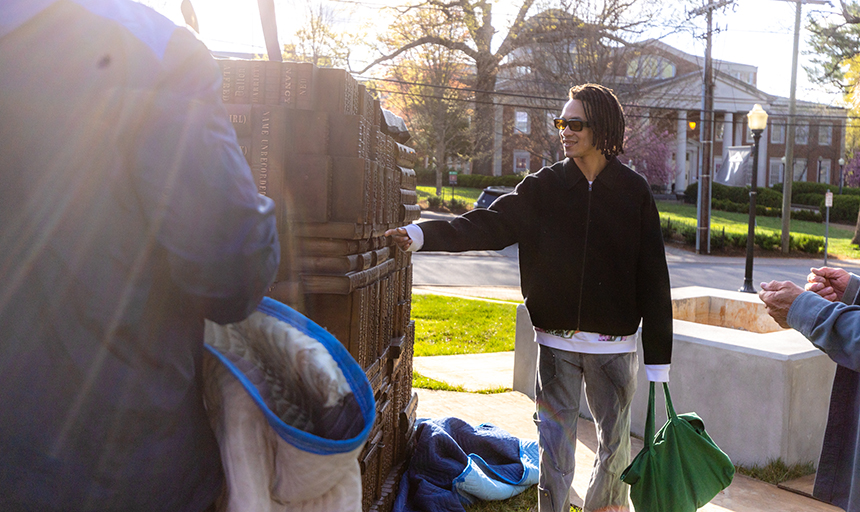Roanoke College to dedicate “Authors and Architects” memorial to enslaved laborers
April 01, 2025
Category: Campus

Roanoke College will celebrate a momentous addition to campus at 4:30 p.m. on Friday, April 4, 2025, when it hosts a dedication ceremony for “Authors and Architects,” a memorial sculpture that recognizes and honors the role of enslaved people in the college’s history. The sculpture, selected in partnership with Creative Time and designed by Richmond artist Sandy Williams IV, is a significant milestone in the college’s extensive inquiry into the history of slavery at Roanoke and the role of enslaved people in the development of the college and the surrounding area.
The installation and dedication of the memorial is the culmination of more than 10 years of work to uncover and understand the role of slavery in the life of the college, and it coincides with the release of a report on the history of enslavement at Roanoke. That work has included membership in the Universities Studying Slavery organization; establishment of the Center for Studying Structures of Race (CSSR); dedication of placards on the Administration Building; creation of a campus walking tour; memorial planning; and in-depth research conducted by CSSR Director, College Historian and Professor Jesse Bucher and his students.
“The ‘Authors and Architects’ memorial on our campus is a meaningful tribute and a powerful reminder of the 829 enslaved individuals who, at great sacrifice, helped create what Roanoke College is today,” said Roanoke College President Frank Shushok Jr. “We take time to acknowledge that all community members, past, present and future, will have benefitted from their lives.”
The dedication ceremony will take place at the memorial site at 226 Maxey Way, across from Roselawn. The large bronze sculpture, which was installed this week, is in the form of hundreds of stacked books, many of which are embossed with the names of enslaved people with ties to the school’s history. Those names have been identified in hours of research conducted by 15 Roanoke College students as part of the Genealogy of Slavery (GOS) project, which began in 2019. One year later, in 2020, the college established the CSSR.
The books that make up the cube-shaped sculpture were cast from 3D scanned replicas of the college’s original library and record books. The sculpture will create a physical presence dedicated to the memory of enslaved laborers. At the same time, it will acknowledge the freedom and education denied to them in their own time and underscore the immense importance they played in the establishment and success of the Roanoke community.
"This work strengthens our community and ensures that the contributions of all those who shaped our institution—named and unnamed—are remembered and respected.”
Board Chair Malon Courts '92
The History of Enslavement Report, written by Bucher to summarize the work of the GOS project, was produced in response to a formal request from the Roanoke College Board of Trustees. The report includes an abundance of details from official records that establish the fact that Roanoke College directly benefited, and even grew stronger, as a direct result of the widespread practice of enslavement.
“Enslaved artisans, skilled craftspeople, and laborers built the college’s original buildings,” the report reads. “Founders of the college, especially members of the Board of Trustees and faculty, owned and enslaved human beings. These enslavers frequently invested wealth produced by enslaved people into the college. The foundational gifts that subsidized the college’s finances and construction projects came from individuals who accumulated and derived significant surplus wealth by owning enslaved people.”
The report also explains that researchers decided, midway through the GOS project, to record information about every named enslaved person they encountered in the sources. That data was used to create the Genealogy of Slavery Database, a website that captures as many details as possible about the people who surfaced in the research. Because much of this data has been erased from history or buried in local archives, the database will serve as a valuable resource for researchers interested in family and local history.
“We recognize our student researchers, College Historian and Professor Jesse Bucher, and other faculty members for their meticulous research that made the History of Enslavement Report possible,” said Roanoke College Board Chair Malon Courts ’92. “Roanoke College remains dedicated to exploring our history with care and integrity as we move forward. This work strengthens our community and ensures that the contributions of all those who shaped our institution—named and unnamed—are remembered and respected.”
Roanoke College partnered with Creative Time, a New York-based public arts nonprofit, to identify an artist for the memorial project and engage the campus community and wider public around the development of the memorial. With Creative Time’s guidance, Roanoke’s Community Vision Committee – a group of faculty, staff, students and community members – reviewed proposals for the memorial before selecting the concept by Williams, an artist and an assistant professor of art at the University of Richmond. Williams has since visited Roanoke College numerous times, including as its Emancipation Week guest speaker in 2024. The college’s Olin Hall Galleries also featured an exhibition of Williams’ work last year.
Creative Time and Roanoke College’s partnership also resulted in a capstone course that links students with leading artists and architects to explore the intersection of memorials, monument and memory, as well as a lecture series centered around the mission of the CSSR and the facilitation of a community survey. To actualize the memorial commission, Creative Time worked closely with two dozen artists to develop and finalize their proposals. Out of a shortlist of proposals, Williams’ sculpture was selected by a jury of college stakeholders, local community members and representatives of the art world.
“My hope is that this experience at the memorial will help humanize the legacy of people who were enslaved in ways that are currently absent from official records and histories,” Williams said.